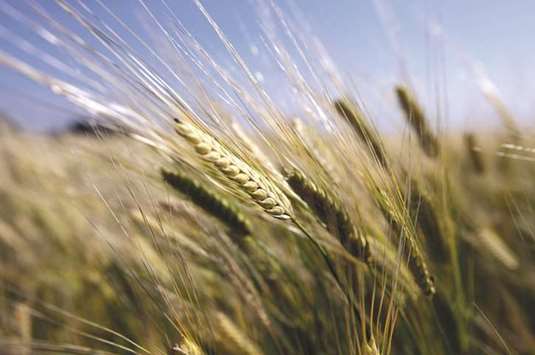Wildfires, drought and severe heat: It’s shaping up to be one of the most perilous wheat seasons in years. Dry weather is plaguing crops from Australia to the US, yields are under threat and world stockpiles are forecast to fall. It’s quite the turnaround for a market that was saddled with a massive supply glut for years, and investors are taking notice.
Prices are rallying across the globe. In the US, July futures for the hard red winter variety have jumped 18% in 2018, the second-best performer among the 22 components of the Bloomberg Commodity Index.
Hedge funds are now wagering on more gains, backing away from the negative bets they held for the better part of the past nine months. At the same time, Rabobank has sounded the alarm for a potentially “explosive” move higher for US prices.
“We have had an abundance of wheat, but we have started to ratchet that down,” said Arlan Suderman, the chief commodities economist for INTL FCStone in Kansas City, Missouri. “Weather is helping us reduce the stockpiles.”
Global wheat inventories are forecast to drop 2.3% in the 2018-2019 season to 264.3mn metric tonnes, according to the US Department of Agriculture. That would mark the first decline in six years as production falls. If the dry patterns continue and yield losses increase, the reduction for reserves could be even greater.
The July contract for soft red winter wheat traded in Chicago, considered an industry benchmark, has jumped 15% in 2018 to close at $5.2325 a bushel on Friday.
Hedge funds had a net-long position of 15,318 futures and options in the soft red variety as of May 29, according to US Commodity Futures Trading Commission data released on Friday. The holding, which measures the difference between bets on a price decline and wagers on a rise, compares with a net-short wager of 1,685 a week earlier. Long-only wagers jumped 12% to the highest since July 2017, the CFTC data show.
In Canada, swaths of the main growing regions have received less than 60% of average precipitation, according to the nation’s agriculture ministry. Plants are now in a critical growing stage, and many areas will need substantial moisture in the next two weeks to ensure crops emerge, according to Levi Wood, president of the Western Canadian Wheat Growers.
“We haven’t had a big general soaking,” Wood said by telephone from his farm near Regina, Saskatchewan. “It’s very concerning in some areas as the dryness continues to persist.”
Drought is extending across parts of North America through the US Plains including in Kansas, the nation’s top producer. Stressed plants mean farmers may abandon more crops than usual this year, especially after fields also suffered through an unusual spring freeze and hail.
Along with the drought, record low acres for hard red winter wheat and late planting of the spring variety may mean the “potential for an explosive upside move for US wheat prices is high,” Stephen Nicholson, a Rabobank analyst, said in a report released on Friday.
Meanwhile in Australia, wheat output may be lower than expected as warm, dry conditions are forecast to continue through the nation’s winter.
The outlook follows one of the country’s warmest autumns on record and its second-hottest summer. Farmers, who began planting in late April, are waiting for rain after many crops were sown into dry soil.
“What people are forecasting is a reasonable shift in the wheat market from supply comfort to neutral supply conditions,” said Tobin Gorey, an agriculture analyst at Commonwealth Bank of Australia. “That has allowed prices to pick up globally.”
Dryness is also a problem in Russia, where the wheat crop is forecast to fall 14% in the 2018-2019 season, according to Dmitry Rylko, director general of consultant the Institute for Agriculture Market Studies in Moscow. Crops have suffered in the country’s south, the main growing region.
“We still have a few weeks for the development of the crop in the south, and a lot will depend on how it goes,” Rylko said. “If it rains in the next two weeks, let’s say that won’t make the crop much better, but will slow its deterioration.”

Global wheat inventories are forecast to drop 2.3% in the 2018-2019 season to 264.3mn metric tonnes, according to the US Department of Agriculture
